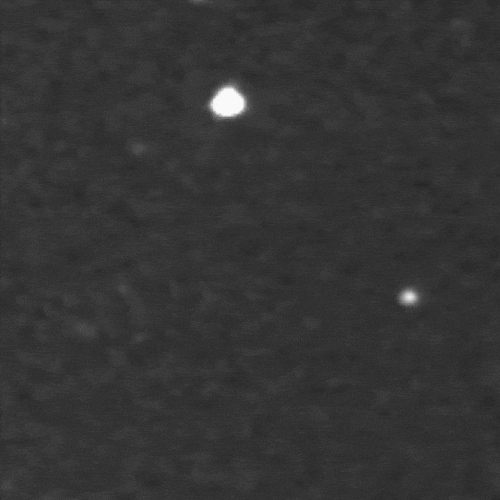Last September, humanity conducted its first real test of planetary defense. And as the saying goes, a good offense is the best defense, so we “took the fight” directly to the asteroids. NASA’s DART mission impacted Dimorphos, the smaller companion of asteroid Didymos, changing its orbit. Immediate analysis showed it was a success, and follow-up studies released today confirm that it went beyond our expectations.
DART stands for Double Asteroid Redirection Test, and it is a kinetic impactor. This approach to planetary defense sees a small but fast spacecraft slamming into the “dangerous” object. The impact imparts momentum onto the celestial body and shifts its orbit. Dimorphos was not dangerous, but since it orbited Didymos it was an excellent testing ground to see how much its orbit could be moved inwards by slowing it down. The expectation from the impact alone was to shorten its period by seven minutes. The final result was around 33 minutes, and that was due to the cloud of debris released.
“People may think of the DART mission as a fairly straightforward experiment that is similar to playing billiards in space – one solid spacecraft impacts into one solid asteroid. However, asteroids are far more complex than just a solid rock, in fact most asteroids are what we think of as rubble piles,” Dr Cristina Thomas, from Northern Arizona University, told IFLScience.
Thomas is one of the lead authors of the five papers published today about the impact (literal and metaphorical) of the DART mission. Her paper focused on the change in the period of Dimorphos. Together this research provides our current best understanding of the test, and provides insight into other bodies and planetary defense. The momentum delivered was estimated in a different paper, suggesting that more momentum came from the ejected material than from the impact alone.
“If you hit a rubble pile with a spacecraft, a lot of material will be ejected and fly away from the object. We see this in our early post-impact images. That ejected material carries momentum. The period change that we observe is not just the result of the momentum transfer from the impacting spacecraft, but also due to that extra momentum boost from the motion of the ejected material,” Thomas explained to IFLScience.
“For a perfectly inelastic collision – one solid spacecraft directly impacting the asteroid with no material ejected – the orbital period change was estimated to be seven minutes. When we included the ejected material in the pre-impact analysis, we had a wide range of period change predictions all the way up to slightly more than 40 minutes.”
The DART impact is estimated to have taken place between two boulders, one of which was grazed by the spacecraft as it crashed into the asteroid. The event was followed by a small spacecraft called LICIACube, as well as multiple telescopes in space and on Earth.
Among them, there were also citizen scientists using Unistellar telescopes who were able to track the formation and the evolution of the cloud of debris. One observer in Kenya and two on Réunion Island saw the impact live, and people around the world followed up with observations of being able to determine the properties of the plume.

The DART impact as seen from a Unistellar telescope. Image credit: Susan Murabana / The Travelling Telescope courtesy of Unistellar
“We didn’t expect to see it as clearly. You see the asteroid brightening up and then a plume around it that diffuses,” Laurent Marfisi, Founder and Chief Executive Officer of Unistellar, told IFLScience. “We had the strength of the network of users we have, which allowed us to follow the aftermath of this during one month to see the evolution of the plume.”
The citizen scientists, all co-authors on the paper, measured the brightness (or magnitude) of the dual asteroid system, which allowed them to estimate a lot of properties of the object. The event created an artificial “comet” or an active asteroid. This actually gives insight in the study of active asteroids, as discussed in another paper. Unistellar estimated that the material released was between 0.3 and 0.5 percent of the mass of Dimorphos.
“From the magnitude, and making assumptions on the size of the grains from active main-belt comet observations, we derived the mass loss in the impact. This is key in our paper; we basically treated the impact as the creation of a comet to be able to derive meaningful data which at the end agrees with the ones derived from other methods like the change in the period of Dimorphos,” Dr Franck Marchis, co-founder and Scientific Director of Unistellar, told IFLScience.
Marfisi also highlights the ability of the Unistellar telescopes to see in color. They saw that the eject had a distinct red hue. It is currently unclear if it was an effect of light through the dust or a true color. The European Space Agency’s Hera mission, which launches next year, will get to the asteroids in late 2026 and will provide more insights into that.
There is no known asteroid that poses a threat to Earth, at least for the next 100 years. Our catalog of the smaller objects that could produce regional devastation, though, is still not fully complete. Albeit with the hope of never having to be employed, planetary defense methods are important. And DART shows that kinetic impactors work, as reported in another paper in this release.
“If we needed to use a kinetic impactor we can expect more deflection from the impactor than in a simple collision. This means that we could change an asteroid’s path with less warning time. This fact would be so incredibly important if we needed to deflect an actual target,” Thomas told IFLScience.
Thomas’ paper and all the others are published in the journal Nature.
Source Link: Humans Really Did Manage To Move A Celestial Body - And By A Fair Bit!